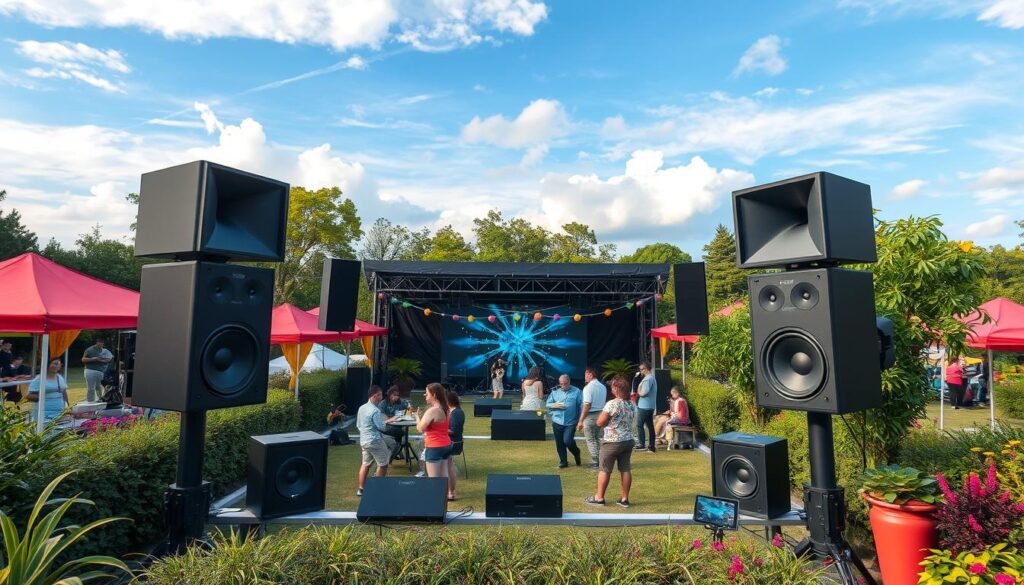
Outdoor sound systems bring life to backyard BBQs, pool parties, and peaceful evenings under the stars. But if those speakers are exposed to the elements, they’re vulnerable to dust, pollen, mildew, bird droppings, spiderwebs, and more. Over time, this buildup can muffle sound quality, discolor speaker housing, and even lead to premature failure of internal components.
While power washing may seem risky around electronics, with the right technique and preparation, you can use it to maintain your outdoor sound systems safely and effectively. This guide will show you how to power wash speaker zones without damaging the gear or the surrounding area.
🔊 What Counts as an Outdoor Sound System?
Outdoor audio setups come in several forms, including:
- Wall-mounted or ceiling-mounted weatherproof speakers
- Rock speakers (designed to blend into landscaping)
- Landscape satellite speakers around patios or gardens
- In-ground subwoofers or planter-style speakers
- Bluetooth speaker mounts near grills or pool areas
Each of these is designed to withstand moisture to some extent—but not all are waterproof. Most are only weather-resistant, meaning they can handle rain but not direct, high-pressure water exposure.
🧼 What You’ll Need
- Electric pressure washer (1,200–1,800 PSI)
- 40° fan tip nozzle
- Mild soap or exterior cleaner (biodegradable)
- Microfiber cloths
- Soft-bristle brush or sponge
- Plastic sheeting or zip-lock bags
- Painter’s tape
- Ladder (if speakers are mounted high)
- Safety gloves and goggles 😎🧤
Browse Amazon Here For Top Rated Power Washers And Accessories
⚠️ Safety First: Prep Before You Spray
Before you get anywhere near the speakers with a pressure washer:
1. Turn Off the System
- Shut down the amplifier or streaming device.
- Unplug any outdoor Bluetooth speakers or battery-powered units.
- If the speakers are hardwired, shut off the breaker to the circuit.
2. Cover and Protect the Speakers
- Wrap each speaker tightly in plastic sheeting or use zip-lock bags with painter’s tape to seal off sensitive areas.
- Focus on sealing the grille, ports, and control panels.
💡 Pro Tip: Only clean the exterior housing with water. Never aim water directly into a speaker grille or woofer.
Browse Amazon Here For Power Washing Safety Equipment
🧽 Cleaning the Speaker Surrounding Area
Start by cleaning the surfaces around the speakers, such as:
- Walls and ceilings for mounted units
- Deck railings or fence posts for landscape speakers
- Rocks, planters, or mulch around ground units
- Nearby surfaces that can reflect sound, like patio walls
This helps maintain a clean sound environment and keeps debris from falling back onto your gear.
Step-by-Step Power Washing:
1. Remove Loose Debris
- Use a soft brush to dust off spiderwebs, pollen, and leaves.
- Check speaker housings for wasp nests or insect build-up.
- Use a microfiber cloth to gently wipe away surface grime before pressure washing.
2. Apply Cleaning Solution
- Use your pressure washer’s soap nozzle or apply cleaner manually using a sponge.
- Stick to plant-safe, biodegradable soaps—especially if you’re near gardens or pools.
- Let it dwell for 5–10 minutes, but do not let it dry.
3. Rinse Surroundings (NOT the Speakers)
- Attach a 40° fan tip for a gentle spray.
- Keep the pressure washer wand at least 3–4 feet away from speaker housings.
- Spray around the speakers, not directly at them.
- Use angled, sweeping motions to rinse walls, ceiling eaves, or ground fixtures.
4. Hand-Clean the Speaker Housing
Once surrounding areas are rinsed:
- Remove plastic coverings carefully.
- Use a damp microfiber cloth to wipe down the speaker housing.
- Use a soft toothbrush or cotton swab to clean out crevices or control panels.
- Never use abrasive pads, bleach, or alcohol-based cleaners on speaker surfaces.
5. Dry and Reconnect
- Allow everything to air dry completely before restoring power.
- For battery or Bluetooth speakers, inspect charging ports and buttons for residual moisture.
- Reconnect and test sound levels, clarity, and wireless connectivity.
❌ Mistakes to Avoid
- ❌ Spraying directly into the speaker grille
- ❌ Using a high-pressure nozzle like 0° or 15°
- ❌ Leaving speakers powered during cleaning
- ❌ Using harsh cleaners that can damage plastic or coatings
- ❌ Forgetting to cover speaker connections and inputs
🌿 Eco-Friendly Tips
- Mix white vinegar and water to clean grime without chemicals.
- Use castile soap for general surface cleaning near speaker zones.
- Rinse runoff into grass or gravel—not into storm drains.
🧠 Maintenance Tips for Long-Term Speaker Health
| Task | Frequency |
|---|---|
| Dust speaker housings | Weekly |
| Clean surrounding area | Monthly |
| Inspect for mold/insects | Bi-monthly |
| Full wipe down with cloth | Quarterly |
| Speaker-safe power wash zone | Twice a year |
Bonus tip: Apply a UV-protective coating to plastic speaker housings if exposed to strong sunlight year-round ☀️.
💬 Final Thoughts
Power washing can absolutely be a part of maintaining a crisp, high-quality outdoor sound experience—as long as you approach it with care. The key is to clean the environment around the speakers, not the speakers themselves with direct pressure.
Think of it like a concert venue: clean the stage, sweep the seats, dust the equipment—but don’t turn a fire hose on the speakers. With this approach, your tunes will sound as clear as the day they were installed. 🎶🧼🔊
Browse Amazon Here For Top Rated Power Washers And Accessories



